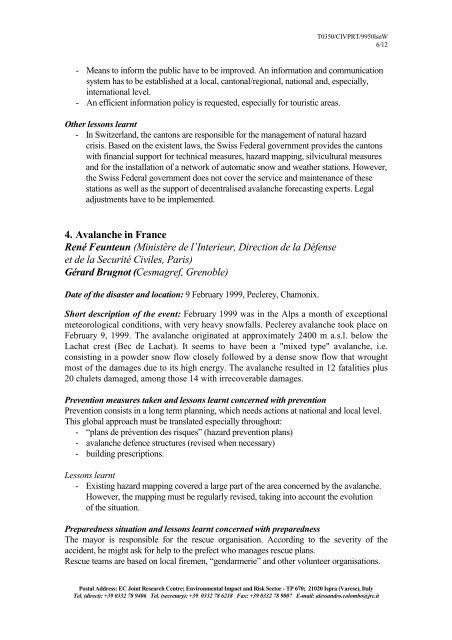lessons learnt from avalanche disasters - PreventionWeb
lessons learnt from avalanche disasters - PreventionWeb
lessons learnt from avalanche disasters - PreventionWeb
Create successful ePaper yourself
Turn your PDF publications into a flip-book with our unique Google optimized e-Paper software.
T0350/CIVPRT/9950lsnW<br />
6/12<br />
- Means to inform the public have to be improved. An information and communication<br />
system has to be established at a local, cantonal/regional, national and, especially,<br />
international level.<br />
- An efficient information policy is requested, especially for touristic areas.<br />
Other <strong>lessons</strong> <strong>learnt</strong><br />
- In Switzerland, the cantons are responsible for the management of natural hazard<br />
crisis. Based on the existent laws, the Swiss Federal government provides the cantons<br />
with financial support for technical measures, hazard mapping, silvicultural measures<br />
and for the installation of a network of automatic snow and weather stations. However,<br />
the Swiss Federal government does not cover the service and maintenance of these<br />
stations as well as the support of decentralised <strong>avalanche</strong> forecasting experts. Legal<br />
adjustments have to be implemented.<br />
4. Avalanche in France<br />
René Feunteun (Ministère de l’Interieur, Direction de la Défense<br />
et de la Securité Civiles, Paris)<br />
Gérard Brugnot (Cesmagref, Grenoble)<br />
Date of the disaster and location: 9 February 1999, Peclerey, Chamonix.<br />
Short description of the event: February 1999 was in the Alps a month of exceptional<br />
meteorological conditions, with very heavy snowfalls. Peclerey <strong>avalanche</strong> took place on<br />
February 9, 1999. The <strong>avalanche</strong> originated at approximately 2400 m a.s.l. below the<br />
Lachat crest (Bec de Lachat). It seems to have been a "mixed type" <strong>avalanche</strong>, i.e.<br />
consisting in a powder snow flow closely followed by a dense snow flow that wrought<br />
most of the damages due to its high energy. The <strong>avalanche</strong> resulted in 12 fatalities plus<br />
20 chalets damaged, among those 14 with irrecoverable damages.<br />
Prevention measures taken and <strong>lessons</strong> <strong>learnt</strong> concerned with prevention<br />
Prevention consists in a long term planning, which needs actions at national and local level.<br />
This global approach must be translated especially throughout:<br />
- “plans de prévention des risques” (hazard prevention plans)<br />
- <strong>avalanche</strong> defence structures (revised when necessary)<br />
- building prescriptions.<br />
Lessons <strong>learnt</strong><br />
- Existing hazard mapping covered a large part of the area concerned by the <strong>avalanche</strong>.<br />
However, the mapping must be regularly revised, taking into account the evolution<br />
of the situation.<br />
Preparedness situation and <strong>lessons</strong> <strong>learnt</strong> concerned with preparedness<br />
The mayor is responsible for the rescue organisation. According to the severity of the<br />
accident, he might ask for help to the prefect who manages rescue plans.<br />
Rescue teams are based on local firemen, “gendarmerie” and other volunteer organisations.<br />
Postal Address: EC Joint Research Centre; Environmental Impact and Risk Sector - TP 670; 21020 Ispra (Varese), Italy<br />
Tel. (direct): +39 0332 78 9406 Tel. (secretary): +39 0332 78 6218 Fax: +39 0332 78 9007 E-mail: alessandro.colombo@jrc.it












![View full document [PDF 988.55 KB] - PreventionWeb](https://img.yumpu.com/47733942/1/184x260/view-full-document-pdf-98855-kb-preventionweb.jpg?quality=85)
![View full document (in French) [PDF 4.96 MB] - PreventionWeb](https://img.yumpu.com/47223870/1/184x260/view-full-document-in-french-pdf-496-mb-preventionweb.jpg?quality=85)


![View full document [PDF 25.02 MB] - PreventionWeb](https://img.yumpu.com/44204570/1/190x234/view-full-document-pdf-2502-mb-preventionweb.jpg?quality=85)
